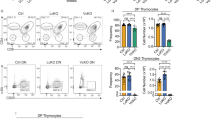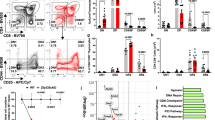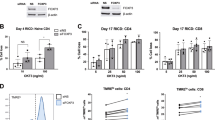Abstract
Bak and Bax are required and redundant regulators of an intrinsic mitochondrial cell death pathway. To analyze this pathway in T cell development and homeostasis, we reconstituted mice with Bak−/−Bax−/− hematopoietic cells. We found that the development and selection of Bak−/−Bax−/− thymocytes was disrupted, with altered representation of thymic subsets and resistance to both death-by-neglect and antigen receptor–induced apoptosis. Elimination of Bak−/−Bax−/− T cells that responded to endogenous superantigen was also reduced. Despite more efficient early reconstitution and apoptotic resistance of Bak−/−Bax−/− thymocytes, thymic cellularity declined over time. Reduced thymic cellularity resulted from a progressive cessation of thymopoiesis. However, animals developed splenomegaly as a result of accumulated memory T cells that were not deleted after antigen-driven expansion. These data indicate that Bak and Bax are required for thymic selection and peripheral lymphoid homeostasis and suggest that thymopoiesis can be negatively regulated by the accumulation of cells that would normally be eliminated by pro-apoptotic Bcl-2–related genes.
This is a preview of subscription content, access via your institution
Access options
Subscribe to this journal
Receive 12 print issues and online access
$209.00 per year
only $17.42 per issue
Buy this article
- Purchase on Springer Link
- Instant access to full article PDF
Prices may be subject to local taxes which are calculated during checkout









Similar content being viewed by others
References
Marrack, P. et al. Homeostasis of αβ TCR+ T cells. Nature Immunol. 1, 107–111 (2000).
Van Parijs, L., Biuckians, A. & Abbas, A.K. Functional roles of Fas and Bcl-2-regulated apoptosis of T lymphocytes. J. Immunol. 160, 2065–2071 (1998).
Vander Heiden, M.G., Chandel, N.S., Schumacker, P.T. & Thompson, C.B. Bcl-xLprevents cell death following growth factor withdrawal by facilitating mitochondrial ATP/ADP exchange. Mol. Cell 3, 159–167 (1999).
Grillot, D.A., Merino, R. & Nunez, G. Bcl-XL displays restricted distribution during T cell development and inhibits multiple forms of apoptosis but not clonal deletion in transgenic mice. J. Exp. Med. 182, 1973–1983 (1995).
Chao, D.T. et al. Bcl-xL and Bcl-2 repress a common pathway of cell death. J. Exp. Med. 182, 821–828 (1995).
Rathmell, J.C., Vander Heiden, M.G., Harris, M.H., Frauwirth, K.A. & Thompson, C.B. In the absence of extrinsic signals, nutrient utilization by lymphocytes is insufficient to maintain either cell size or viability. Mol. Cell 6, 683–692 (2000).
Veis, D.J., Sorenson, C.M., Shutter, J.R. & Korsmeyer, S.J. Bcl-2-deficient mice demonstrate fulminant lymphoid apoptosis, polycystic kidneys, and hypopigmented hair. Cell 75, 229–240 (1993).
Motoyama, N. et al. Massive cell death of immature hematopoietic cells and neurons in Bcl-x-deficient mice. Science 267, 1506–1510 (1995).
Brady, H.J., Gil-Gomez, G., Kirberg, J. & Berns, A.J. Bax α perturbs T cell development and affects cell cycle entry of T cells. EMBO J. 15, 6991–7001 (1996).
O'Connor, L. et al. Bim: a novel member of the Bcl-2 family that promotes apoptosis. EMBO J. 17, 384–395 (1998).
Bouillet, P. et al. Proapoptotic Bcl-2 relative Bim required for certain apoptotic responses, leukocyte homeostasis, and to preclude autoimmunity. Science 286, 1735–1738 (1999).
Bouillet, P. et al. BH3-only Bcl-2 family member Bim is required for apoptosis of autoreactive thymocytes. Nature 415, 922–926 (2002).
Knudson, C.M., Tung, K.S., Tourttellotte, W.G., Brown, G.A. & Korsmeyer, S.J. Bax-deficient mice with lymphoid hyperplasia and male germ cell death. Science 270, 96–99 (1995).
Lindsten, T. et al. The combined functions of proapoptotic Bcl-2 family members bak and bax are essential for normal development of multiple tissues. Mol. Cell 6, 1389–1399 (2000).
Wei, M.C. et al. tBID, a membrane-targeted death ligand, oligomerizes BAK to release cytochrome c. Genes Dev. 14, 2060–2071 (2000).
Cheng, E.H.-Y. et al. BCL-2, BCL-xL sequester BH3 domain-only molecules preventing BAX- and BAK-mediated mitochondrial apoptosis. Mol. Cell 8, 705–711 (2001).
Zong, W.X., Lindsten, T., Ross, A.J., MacGregor, G.R. & Thompson, C.B. BH3-only proteins that bind pro-survival Bcl-2 family members fail to induce apoptosis in the absence of Bax and Bak. Genes Dev. 15, 1481–1486 (2001).
Sebzda, E. et al. Selection of the T cell repertoire. Annu. Rev. Immunol. 17, 829–874 (1999).
Baird, A.M., Gerstein, R.M. & Berg, L.J. The role of cytokine receptor signaling in lymphocyte development. Curr. Opin. Immunol. 11, 157–166 (1999).
Wei, M.C. et al. Proapoptotic BAX and BAK: a requisite gateway to mitochondrial dysfunction and death. Science 292, 727–730 (2001).
Peterson, D.O., Kriz, K.G., Marich, J.E. & Toohey, M.G. Sequence organization and molecular cloning of mouse mammary tumor virus DNA endogenous to C57BL/6 mice. J. Virol. 54, 525–531 (1985).
Gollob, K.J. & Palmer, E. Divergent viral superantigens delete Vβ5+ T lymphocytes. Proc. Natl. Acad. Sci. USA 89, 5138–5141 (1992).
Fink, P., Fang, C.A. & Turk, G.L. The induction of peripheral tolerance by the chronic activation and deletion of CD4+Vβ5+ cells. J. Immunol. 152, 4270–4281 (1994).
Zuniga-Pflucker, J.C. & Lenardo, M.J. Regulation of thymocyte development from immature progenitors. Curr. Opin. Immunol. 8, 215–224 (1996).
Weist, D.L., Berger, M.A. & Carleton, M. Control of early thymocyte development by the pre-T cell receptor complex: A receptor without a ligand? Semin. Immunol. 11, 251–262 (1999).
Huesmann, M., Scott, B., Kisielow, P. & von Boehmer, H. Kinetics and efficacy of positive selection in the thymus of normal and T cell receptor transgenic mice. Cell 66, 533–540 (1991).
Falk, I., Nerz, G., Haidl, I., Krotkova, A. & Eichmann, K. Immature thymocytes that fail to express TCRβ and/or TCRγδ proteins die by apoptotic cell death in the CD44−CD25− (DN4) subset. Eur. J. Immunol. 31, 3308–3317 (2001).
Sentman, C.L., Shutter, J.R., Hockenbery, D., Kanagawa, O. & Korsmeyer, S.J. Bcl-2 inhibits multiple forms of apoptosis but not negative selection in thymocytes. Cell 67, 879–888 (1991).
Strasser, A., Harris, A.W. & Cory, S. Bcl-2 transgene inhibits T cell death and perturbs thymic self–censorship. Cell 67, 889–899 (1991).
Siegal, R.M. et al. Inhibition of thymocyte apoptosis and negative antigenic selection in bcl-2 transgenic mice. Proc. Natl. Acad. Sci. USA 89, 7003–7007 (1992).
Strasser, A., Harris, A.W., Von Boehmer, H. & Cory, S. Positive and negative selection of T cells in T-cell receptor transgenic mice expressing a bcl-2 transgene. Proc. Natl. Acad. Sci. USA 91, 1376–1380 (1994).
Williams, O., Norton, T., Halligey, M., Kioussis, D. & Brady, H.J.M. The action of Bax and Bcl-2 on T cell selection. J. Exp. Med. 188, 1125–1133 (1998).
McGargill, M.A. & Hogquist, K.A. Antigen-induced coreceptor down-regulation on thymocytes is not a result of apoptosis. J. Immunol. 162, 1237–1245 (1999).
Gao, J.-X. et al. Perinatal blockade of B7-1 and B7-2 inhibits clonal deletion of highly pathogenic autoreactive T cells. J. Exp. Med. 195, 959–971 (2002).
Linette, G.P., Li, Y., Roth, K. & Korsmeyer, S.J. Cross talk between cell death and cell cycle progression: BCL-2 regulates NFAT-mediated activation. Proc. Natl. Acad. Sci USA 93, 9545–9552 (1996).
Mazel, S., Burtrum, D. & Petrie, H.T. Regulation of cell division cycle progression by bcl-2 expression: A potential mechanism for inhibition of programmed cell death. J. Exp. Med. 183, 2219–2226 (1996).
O'Reilly, L.A., Huang, D.C.S. & Strasser, A. The cell death inhibitor Bcl-2 and its homologues influence control of cell cycle entry. EMBO J. 15, 6979–6990 (1996).
Willerford, D.M. et al. Interleukin-2 receptor α chain regulates the size and content of the peripheral lymphoid compartment. Immunity 3, 521–530 (1995).
Tivol, E.A. et al. Loss of CTLA-4 leads to massive lymphoproliferation and fatal multiorgan tissue destruction, revealing a critical negative regulatory role of CTLA-4. Immunity 3, 541–547 (1995).
Waterhouse, P. et al. Lymphoproliferative disorders with early lethality in mice deficient in Ctla-4. Science 270, 985–988 (1995).
Chambers, C.A., Cado, D., Truong, T. & Allison, J.P. Thymocyte development is normal in CTLA-4-deficient mice. Proc. Natl. Acad. Sci. USA 94, 9296–9301 (1997).
Kitchen, S.G., Killian, S., Giorgi, J.V. & Zack, J.A. Functional reconstitution of thymopoiesis after human immunodeficiency virus infection. J. Virol. 74, 2943–2948 (2000).
Markert, M.L. et al. Thymopoiesis in HIV-infected adults after highly active antiretroviral therapy. AIDS Res. Hum. Retroviruses 17, 1635–1643 (2001).
Acknowledgements
We thank D. R. Plas and K. A. Frauwirth for helpful discussions. Supported by the Irvington Institute for Immunological Research (to J. C. R.), the Cancer Research Institute (to W. X. Z.) and the National Cancer Institute.
Author information
Authors and Affiliations
Corresponding author
Ethics declarations
Competing interests
The authors declare no competing financial interests.
Rights and permissions
About this article
Cite this article
Rathmell, J., Lindsten, T., Zong, WX. et al. Deficiency in Bak and Bax perturbs thymic selection and lymphoid homeostasis. Nat Immunol 3, 932–939 (2002). https://doi.org/10.1038/ni834
Received:
Accepted:
Published:
Issue Date:
DOI: https://doi.org/10.1038/ni834
This article is cited by
-
BCL-2 protein family: attractive targets for cancer therapy
Apoptosis (2023)
-
Royal jelly protects brain tissue against fluoride-induced damage by activating Bcl-2/NF-κB/caspase-3/caspase-6/Bax and Erk signaling pathways in rats
Environmental Science and Pollution Research (2023)
-
Hiding in the dark: pan-cancer characterization of expression and clinical relevance of CD40 to immune checkpoint blockade therapy
Molecular Cancer (2021)
-
Glucocorticoids in T cell development, differentiation and function
Nature Reviews Immunology (2021)
-
The CCR4–NOT deadenylase complex safeguards thymic positive selection by down-regulating aberrant pro-apoptotic gene expression
Nature Communications (2020)



